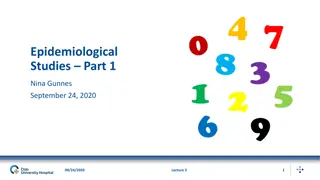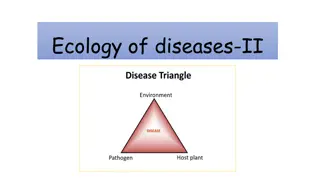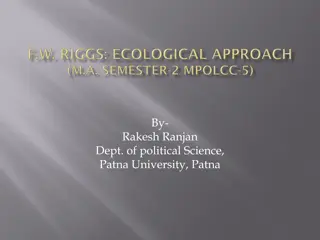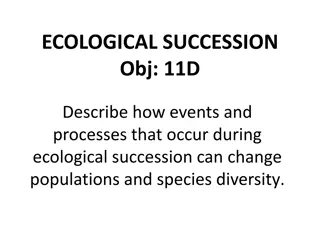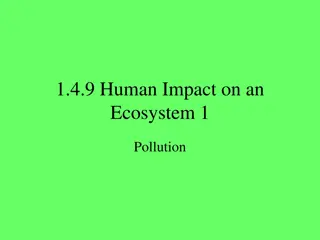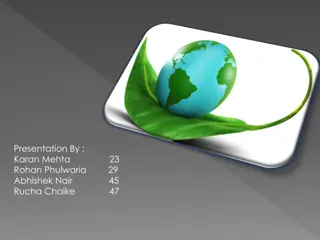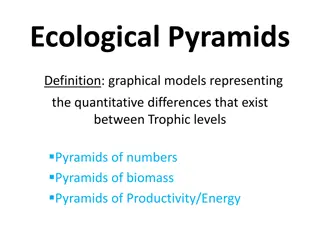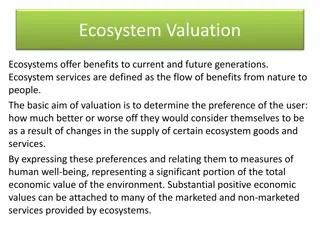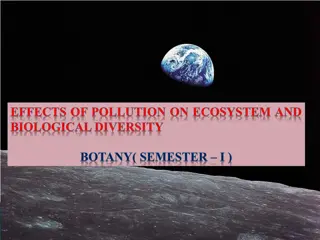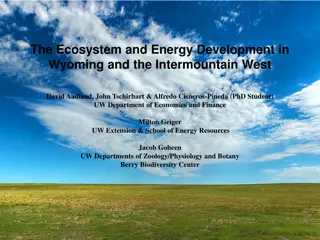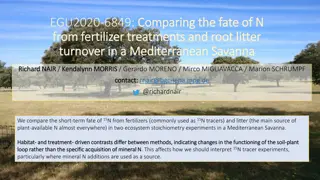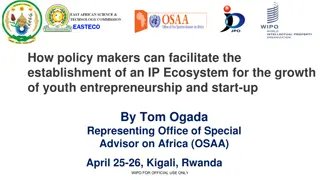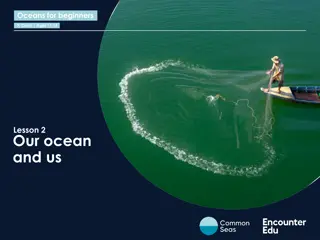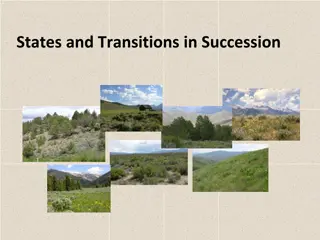Understanding Ecological Consequences in Ecosystem Management
Delana Louw from Rivers for Africa presented on the ecological consequences of various scenarios in ecosystem management. The process involves delineating units of analysis, stakeholder engagement, quantifying ecological water requirements, evaluating scenarios, and determining management classes. By predicting changes in biophysical components and ranking scenarios based on ecological importance, the study emphasizes the importance of considering ecological impacts in decision-making processes.
- Ecosystem Management
- Ecological Consequences
- Stakeholder Engagement
- Scenario Evaluation
- Environmental Conservation
Uploaded on Sep 18, 2024 | 0 Views
Download Presentation

Please find below an Image/Link to download the presentation.
The content on the website is provided AS IS for your information and personal use only. It may not be sold, licensed, or shared on other websites without obtaining consent from the author. Download presentation by click this link. If you encounter any issues during the download, it is possible that the publisher has removed the file from their server.
E N D
Presentation Transcript
ECOLOGICAL CONSEQUENCES Presented by: Delana Louw (Rivers for Africa) 3 April 2014
NWRCS integrated steps 1: Delineate units of analysis and describe the status quo 2: Initiation of stakeholder process and catchment visioning 3: Quantify EWRs and changes in EGSA 4: Identification and evaluation of scenarios within IWRM 5: Draft Management Classes 6: Resource Quality Objectives (EcoSpecs & water quality (user)) 7: Gazette class configuration ECOLOGICAL CONSEQUENCES TO SCENARIOS 2
Determining ecological consequences of scenarios Need to answer the what if questions Express in terms of change in Ecological Category Detailed process to predict changes in all the biophysical components per site and per scenario. Then to integrate and demonstrate in systems context Include in MC DSS process 3
Determining ecological consequences of scenarios Geomorphology Geomorphology Geomorphology AVERAGE SCORE FOR EACH SCENARIO & STANDARDISE TO 1 Physico-chemical Physico-chemical Physico-chemical Fish Fish Fish Macroinvertebrates Macroinvertebrates Macroinvertebrates Riparian vegetation Riparian vegetation Riparian vegetation Consequences EC FOR PES & REC Consequences EC FOR SC Consequences COMPARE EC TO REC Evaluate scenarios Determine PES, REC and % Predict EC and % Determine degree to which REC is met Rank Scenarios at each EWR site
Determining ecological consequences of scenarios Ecological ranking of scenarios per EWR site RELATIVE ECOLOGICAL IMPORTANCE OF SITES PES EIS Locality in conservation areas APPLY WEIGHT WEIGHT Ecological ranking of scenarios for the Letaba system
RESULTS PER EWR SITES: EWR 1 (LETABA) PES, REC, Sc 2, Sc 3 Sc 3 is similar to the present day flows and therefore maintains the PES and REC. 1.00 0.96 , 10 Sc 6 Sc 5 and 6 have lower floods than present day as well as lower base flows. This results in decreased fast habitats impacting on instream habitat and increased stress on the biota. Vegetation is likely to encroach in lower and marginal zones. 0.92 Sc 4, Sc 5 0.88 0.84 0.80 0.76 0.72 0.68
RESULTS PER EWR SITES: EWR 3 (LETABA) Sc 6: Decrease in EC due to reduced high flows. Reduce substrate quality and suitability and species with a preference in this type of habitat may deteriorate. Sc 9: Almost all categories improve from Sc 6 due to the improvement in baseflows (positive for fish with a preference for fast habitat) as well as some smaller floods. Riparian vegetation improvement is in the marginal and lower zones as these floods will reduce encroachment on the macro-channel floor and promote zone health. Sc 10: An improvement from Sc 9 due to the managed EWR floods included as a release. REC 1.00 0.96 Sc 10 0.92 Sc 9 PES, Sc 2 Sc 3 0.88 0.84 Sc 6 Sc 4, Sc 5 0.80 0.76 0.72 0.68
RESULTS PER EWR SITES: EWR 4 (LETABA) Sc 6: Reduced high flows will reduce substrate quality for instream biota. Lack of floods will promote marginal zone vegetation encroachment. REC 1.00 0.96 0.92 Sc 9 and 10: Improved baseflows are offset against decreased spills. The releases of small floods do improve these scenarios from Sc 6. 0.88 PES, Sc 2 0.84 Sc 9 Sc 10 Sc 3 0.80 Sc 6 But, Sc 10 STILL worse than PES 0.76 0.72 Sc 4, Sc 5 0.68
RESULTS PER EWR SITES: EWR 7 (LETABA) Sc 6: Impacts on floods and low flows during the wet season. Similar to Sc 3 but the emphasis will be on decreased floods with resulting decrease in riffle quality. REC 1 0.96 0.92 PES, Sc 2 0.88 Sc 9 and 10. Impacts are similar than at EWR 3 and 4 with Scenario 10 showing the most improvement from Sc 6 due to the release of PES base flows and some EWR floods. Sc 10 0.84 Sc 9 Sc 3 0.8 Sc 6 0.76 BUT, Sc 10 still worse than PES 0.72 Sc 4, Sc 5 0.68
RESULTS PER EWR SITES: EWR 2 (LETSITELE) PES, REC, Sc 2, Sc 3, Sc 4 Sc 3: Similar to PD. 1 Sc 4: Lower flows during the wet season leading to some impact on the instream biota. 0.96 Sc 6 0.92 Sc 5 0.88 Sc 6: Lack of floods result in deterioration of substrate quality and loss of pools. 0.84 0.8 Sc 5: Decreased flows in wet seasons (severe) will result in impact on biota with preference for fast habitats and pools 0.76 0.72 0.68
RESULTS PER EWR SITES: EWR 5 (KLEIN LETABA) PES, REC, Sc 2, Sc 3, Sc 4 1 Sc 4: Similar to PD flows. 0.96 Sc 6: Includes a dam with a low flow EWR release. Reduced flows in the wet season will reduce abundance and suitability of fast habitat. Vegetation encroachment expected. Sc 6 0.92 Sc 5 0.88 0.84 0.8 0.76 Sc 5: Includes a dam - reduced flows in wet season and floods. Similar to Sc 6 with slightly worse conditions. 0.72 0.68
RELATIVE IMPORTANCE OF SITES EWR site Locality in reserves PES EIS Weight Order Moderat e High High High Moderat e Moderat e EWR 1 C 1 0.14 4 EWR 3 EWR 4 EWR 7 C C C 3 2 5 0.19 0.18 0.23 2 3 1 EWR 2 D 1 0.13 5 EWR 5 C 1 0.14 4
RANKING ORDER FOR SYSTEM Ranking order REC PES Sc 10 Sc 3 Sc 9 Sc 6 Sc 4 Sc 5



